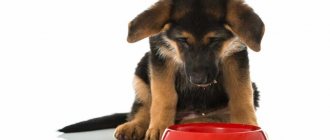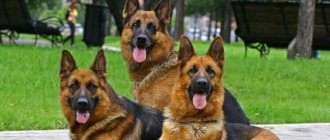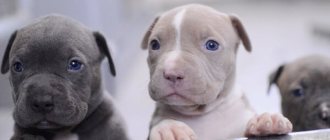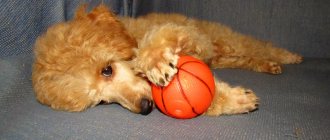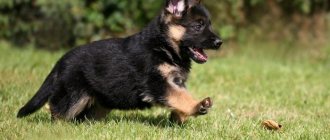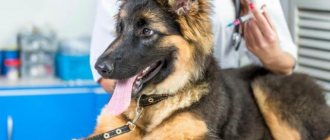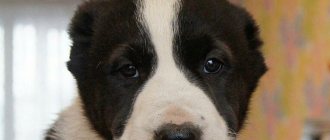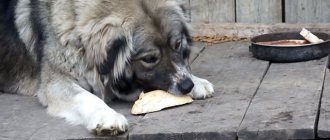The German Shepherd is popular among breeders due to the impressive list of positive qualities of representatives of this breed, including the ability to learn and train, a high level of intelligence, excellent working qualities, etc.
Buying a puppy is a responsible step. It is necessary to decide in advance about the purpose of its purchase and the desired gender, as well as prepare and find out what kind of care it needs.
The purpose of this article is to give future owners of German Shepherds and those who have only recently acquired a puppy of this breed, comprehensive information about the characteristics of these babies and the rules for their maintenance, so that many difficulties can be avoided.
Photos of puppies up to a month old
Newborn puppies cannot see or hear. Among the sense organs, the sense of smell is developed - it is by smell that they find the mother. Also, babies do not have teeth; they appear only after the 20th day of life.
During 1 month of life, they all look alike, have a pointed muzzle, a large black nose and short shiny fur.
German Shepherd puppies are born weighing 350-550 g. Moreover, the more puppies in the litter, the less the weight of each of them.
NOTE!
The presence of sexual dimorphism is clearly visible - females are smaller than males.
As a result of active growth and good nutrition, each baby in the litter gains 100 g per day, and month-old puppies can already weigh about 3-4 kg.
History of the German Shepherd breed
German Shepherd
To trace the history of some breeds (for example, the Doberman and Airedale Terrier, which “come from” the 19th century, or the Old English Bulldog, bred in 1970), it is enough to refer to official documents and eyewitness accounts. With German Shepherds the situation is completely different. According to researchers, the beginning of the chain of their immediate ancestors should be sought in the depths of centuries.
Archaeological finds indicate that back in the 4th millennium BC, animals lived in the territory of modern Czech Republic, Poland and Germany, the skeleton of which has many features similar to shepherd dogs. These were the consequences of the evolution of wild individuals who chose to live near the sites of ancient tribes and became dependent on humans. It is assumed that even then a certain primitive selection was carried out, during which the largest and most obedient puppies were selected.
The now non-existent small Indian wolf increasingly moved away from its “free” relatives and gradually turned into the so-called Bronze Age dogs. Over time, people's needs have changed. Not only farmers, but also pastoralists were, to one degree or another, tied to a particular area. This means that the four-legged companions have new functions. In the Middle Ages, Hofwarts were bred throughout Europe. This German word is translated as “guardian of the yard,” but dogs were not only engaged in protecting real estate.
Domesticated cattle needed reliable protection from ruthless predators and hunters for other people's goods. Given the growing number of herds and flocks, it was simply impossible to cope with such a task with the help of shepherds. It was then that the yard dogs came to the rescue. Of course, not everyone was suitable for such work, but only the most savvy and resilient. They began to be selected and trained in a special way. And everything special is valuable, therefore, already in the 7th century, according to the laws of the ancient German Alemanni tribe, severe punishment awaited the culprit for the murder of a shepherd dog.
German Shepherd puppy
Of course, animals of the early Middle Ages, and even of much later eras, looked little like modern representatives of the breed. What was considered fundamentally important for the so-called primitive German shepherds was not the shape of the head and the position of the tail, but the corresponding intelligence, fairly large dimensions and a “psychological portrait”. The fact is that the lifestyle of shepherds implied long-term isolation; during the grazing season, the animals actually had contact exclusively with “their” person and had to not only obey unquestioningly, but also become good companions to him.
By the 18th century the situation had changed somewhat. Two regional types of German herding dogs took shape at once - the semi-long-haired Thuringian of a fawn-gray color with a curling tail and the long-haired Württemberg of a black or red color with semi-erect ears. They also differed in character: the former were called active animals, prone to loud and frequent barking, while the latter could boast of calmness and endurance. In the name of a common cause, breeders from the central and southwestern lands decided to join forces.
The result of the painstaking work of enthusiasts was presented to the general public only at the end of the 19th century. Baron von Knigge brought two of his pets, males Greif and Kiras, to the Hanover Dog Show in 1882. Later, interest in the new breed was fueled by the owners of the Hannau kennel, who showed the public an impressive pair - large and strongly built Pollux and Prima. It was thanks to them that almost two dozen champions and winners of exhibitions of subsequent decades were born.
In 1891, the creation of the first German Shepherd fanciers' society was announced. The Philax organization did not exist for long, but managed to approve the breed standard. The next significant event should be considered an exhibition in the small city of Karlsruhe on the German-French border. The event would have remained unnoticed by anyone if it had not been possible to see an outstanding representative of the old-format type. And not among the participants!
German Shepherd on duty
Hector von Lirkenhayn merely entertained visitors with a demonstration of herding skills. By a happy coincidence, retired military man Max von Stefanitz and his friend Arthur Meyer passed by, who devoted their free time to breeding German shepherds and immediately noticed the dog’s perfect external characteristics, in no way inferior to its working qualities. The owner, however, did not want to part with his pet so easily; negotiations took several weeks.
Having acquired the ideal “German”, von Stephanitz entered him as number one in the breeding book under a new name - Horand von Grafrath. At the same time, a large-scale search for females similar in type begins. The efforts were rewarded; in the litters received from Horand, a sufficient number of worthy successors of the breed were born. Most modern purebred lines are in one way or another connected with his son Hector von Schwaben, grandsons Pilot, Beowulf, Heinz von Starkenburg. The breeding of the black and yellow dogs recognizable today began with Hetel von Uckermark, son of Roland von Starkenburg. Another outstanding representative of the breed is Claudo von Boxberg, who won the international exhibition in 1925 and laid the foundation for new breeding lines.
Max von Stephanitz died in 1936. There is an opinion that this was indirectly facilitated by attacks from members of the National Socialist Party, who did not want the popularization of German shepherds outside Germany and even threatened the enthusiast with imprisonment in a concentration camp. During the Second World War, many nurseries were destroyed, many animals died, and no one cared about the purity of the blood of the remaining ones. But several valuable representatives of the breed were preserved, and in peacetime, von Stephanitz’s followers continued to work on the development of the breed. Exhibitions resumed in 1946, and five years later a new hero appeared at one of them - champion Rolf von Osnabrücker, the founder of modern “high breeding” lines.
Back in April 1899, the German Shepherd Owners' Union was created. The activities of von Stephanitz, Meyer and other leaders were aimed mainly at maintaining the purity of the blood, which would be confirmed by relevant documents, encouraging outstanding breeders and developing the working qualities of the breed. The organization still exists today, and in May 1968 an international association was founded, which today is known as the World Union of German Shepherd Associations and unites 89 national unions from 82 countries.
Development by day in the first month
For 4-5 days after birth, small puppies react only to pain, cold and hunger. Experiencing these feelings, they actively move and squeak.
By about 2 weeks, their eyes and ear canals open, and their sense organs begin to form. The kids begin to stand on their paws and yawn - they are laying the foundations for the behavior of adult dogs.
| Age | Male weight | Bitch weight |
| 10 days | 1 kg | Up to 800 g |
| 18 days | 2 kg | Up to 1.8 kg |
| 25 days | Up to 3 kg | 2.5 kg |
| 30 days | 3.5-4 kg | 3-3.3 kg |
Where can I buy a puppy?
You need to buy a puppy from a professional kennel that breeds German shepherds. It is there that specialists work who select pairs for mating, taking into account the heredity of the individuals. Some of the most famous nurseries in the Russian Federation:
- “Team Zilber Wasserfall” – Vladimir region, Kolchugino.
- “From the Blue Star” - Moscow.
- "Haus Schiran" - Moscow region.
- "Shvalbennest" - Khabarovsk.
- "Samara Land" - Samara.
- “De Orse Mak Flai” – Moscow region, Vyalki village.
Growth from 1 to 12 months
The table below shows how approximately the parameters of German Shepherd puppies should change during the first year by month:
| Age | Height at withers | Male weight | Bitch weight | Chest circumference |
| 1 month | 19-21 cm | 3.5-4 kg | 3-3.3 kg | 28-31 cm |
| 2 months | 32-38 cm | 8.5-9 kg | 7.5-8 kg | 46-49 cm |
| 3 months | 40-48 cm | 14-14.2 kg | 12-12.3 kg | 56-59 cm |
| 4 months | 47-56 cm | 19-20 kg | 16-16.4 kg | 60-64 cm |
| 5 months | 51-58 cm | 22-22.9 kg | 20-21.7 kg | 65-70 cm |
| 6 months | 52-60 cm | 24-26 kg | 22.5-23 kg | 68-72 cm |
| 7 months | 53-61 cm | 28-28.4 kg | 23-24.7 kg | 70-72 cm |
| 8 months | 53-61 cm | 29-30 kg | 25-25.2 kg | 72-74 cm |
| 9 months | 53-61 cm | 30.5-32 kg | 27-27.5 kg | 74-75 cm |
| 10 months | 54-62 cm | 32.3-32.9 kg | 28-29 kg | 75-76 cm |
| 11 months | 54-62 cm | 33-33.5 kg | 28-29 kg | 75-76 cm |
| 12 months | 55-63 cm | 33-34 kg | 30-32 kg | 75-76 cm |
It is important to understand that the data given in the table are averaged, and the growth and development of the pet may not coincide with them, since first of all it depends on factors such as:
- individual characteristics of the body;
- content;
- feeding and so on.
However, if the deviations are too great and there are doubts about the sequence of development of the puppy, you should consult a veterinarian.
The height of an adult German Shepherd should be approximately equal to the length of its body, excluding the tail, which is why the dog looks almost “square”, and the chest circumference should be 5-7 cm greater than the length of the body.
The active growth phase of German Shepherds ends when they reach one year of age. But the dog’s development does not stop there, and the pet is fully formed only by 2 years. At this time, muscle mass increases, chest volume increases, and bone formation occurs.
Personality of the German Shepherd
Without exception, all owners of German Shepherds call them loyal, intelligent, calm and obedient animals. The key to an excellent character is the animal’s stable psyche and proper upbringing.
Shepherd dog with its owner
The high intelligence of Germans is not accompanied by a desire for independence and stubbornness; they easily and with pleasure master new games, teams, and territories. Dogs do not like loneliness, but they patiently wait for their owner to return. For a good mood and normal well-being, they urgently need human society, including long walks and active games.
One of the important features of the German Shepherd remains its innate protective instincts, therefore they are wary of strangers in the home and even during a walk, although they never show aggression without a reason. The devotion to the owner and family of these pets is raised to the degree of absolute; they are ready to sacrifice themselves, protecting their household from danger, and they assess the degree of danger instantly and adequately.
German Shepherds love children and enjoy playing with them. However, it is not recommended to leave babies alone with a dog, if only because of the difference in size and weight. The shepherd is tolerant of other animals in the house; friendly relations are possible if they grow up together.
Future defender
How to care?
Regular hygiene procedures are necessary to maintain good health of your pet. He should be accustomed to all manipulations as early as possible.
Ear cleaning
Every 2 weeks you need to clean your dog's ears. To do this, apply a special lotion to a cotton pad and carefully clean the inside of the ear.
Normal discharge is thick and yellow in color. If they are dark or purulent and have an unpleasant odor, you should consult a veterinarian.
Wool and combing
Coat care includes quarterly bathing of the pet and combing 2 times a week at normal times and daily during the molting period. To do this, it is best to use a furminator or a metal comb.
Eye care
Representatives of this breed are not prone to ophthalmological diseases and excessive discharge from the eyes, so there is no need to wipe them often.
The appearance of increased lacrimation and thick, purulent discharge, redness of the eyes, swelling of the eyelids is a reason to immediately show the shepherd dog to a specialist.
Nail trimming
Starting from 2 months, you should begin to accustom your pet to trimming its nails. To do this, the dog needs to be laid on its side or sat down, fixed in this position and with a special nail cutter shorten each claw by 2-3 mm so that the blood vessels are not affected.
If more of the nail is cut off than necessary and the shepherd starts bleeding, you need to pour peroxide on the tip of the nail and dip it in manganese powder.
IMPORTANT!
Also, puppy care includes timely vaccination, deworming and treatment for external parasites.
Key facts
The characteristics of the German Shepherd breed are as follows: they are large, strong and incredibly smart dogs with innate guarding, fighting and hunting skills. “Germans” are immensely devoted to their owner, very smart, and given proper upbringing and training, they are efficient and well prepared to perform dangerous tasks. These dogs are friendly and kind to others.
You can keep them in an apartment, but the best option for a pet is fresh air, plenty of space for movement, games, and training. They are very active, inquisitive and smart.
Dogs of this breed will be both excellent guards, “co-workers”, and excellent furry friends, protectors in the family. The most important thing for them is a person’s authority. They are ready to obey unquestioningly, learn, and carry out any commands. The process of training them goes quickly and clearly, because the “Germans” are one of the smartest dogs in the world. An important task for the owner is to start training and training as early as possible.
Interesting
: German Shepherds are wonderful actors, playing leading roles in action-packed films or luxury food commercials.
They do not provoke empty collisions with other animals; first they carefully study the surrounding environment and sniff. Of course, this behavior is achieved through hard training, strict education and the necessary attention.
Germans have a hypersensitive sense of smell. That is why they are used by dog handlers, various military intelligence services, military structures, and the police. They are naturally strong, fast and very agile.
Shepherds are truly incredibly active. It will not be difficult for them to run for hours after a stick or actively play all kinds of games. They need constant communication. For people who love regularity, calmness, or even passivity, this can be a huge inconvenience.
The description of the German Shepherd breed is based primarily on its working qualities. Therefore, the dog certainly needs constant attention from the owner. The lifespan of a German Shepherd depends on properly distributed physical and mental activity - without them, the dog quickly fades away.
What to feed for the first 3 months?
For 3 weeks after birth, puppies eat only mother's milk, then they need to be introduced to complementary foods, gradually transferring them to the diet that adults will have.
The following can be used as complementary foods:
- ready-made dry food, but previously soaked in water, as well as pate or canned food (they must be marked Starter or Puppy);
- pre-frozen scraped or grated lean meat (beef, rabbit or turkey);
- fermented milk products (low-fat cottage cheese, kefir, yogurt).
You cannot use cow's milk, baby formula or food from the common table for complementary feeding.
By 1.5 months, the menu for German Shepherd puppies should include:
- raw and boiled beef, cut into small pieces;
- milk;
- rice and oatmeal porridge;
- cottage cheese, kefir, raw egg.
Upon reaching 2-3 months, the puppies’ body can already digest fiber of plant origin, which means that boiled carrots and 1 tsp can be added to the diet. vegetable oil (for porridge).
An additional source of vitamins and minerals needed by a puppy’s growing body are vegetables and fruits (apples, bell peppers, watermelons) in the summer; vitamin D in oil and raw carrots should be given in winter.
Boiled or raw marrow bones are good for puppies as a treat and to promote jaw development.
What documents should there be?
The only official document certifying the breed of a German Shepherd is its pedigree or (at first) a puppy card. These documents are issued by breeders who have permission from the RKF for breeding.
In turn, the RKF, as a member of the FCI, enters all breeding German shepherds into a common database where you can trace the origin of the dog not only at the level of its parents, but also more distant ancestors. Producers, especially in the working sector, pass standards, undergo health testing (including dysplasia), are evaluated at special breed exhibitions and receive diplomas.
Important! The test results are entered into pedigrees and reflected in the database. The authenticity of the dog is verified by its brand and chip. Any tournament or exhibition event begins with checking the number on the dog’s right ear and in its pedigree.
A serious breeder will not forget to draw up a purchase and sale agreement, which spells out in detail the responsibilities of both parties.
Return to content
How to feed a grown puppy correctly?
For a German Shepherd, the principle of so-called “free” feeding is absolutely unacceptable; it is important to accustom your pet to a feeding regime.
The number of feedings per day depends on age:
- up to 1.5 months – 6 times;
- 1.5-3 months – 5 times;
- 3-6 months – 3 times;
- from 6 months and older – 2 times.
In the first 2 weeks after buying a puppy, you need to feed him the same thing that he ate from the breeder, then the feeding pattern can be changed.
The diet of a German Shepherd can consist of natural products and ready-made industrial food, the main thing is that it is balanced. Otherwise, the puppy may not have erect ears and may develop gastritis or rickets.
Proper nutrition for a dog should consist of 60% of the daily food intake from raw or boiled lean meat.
The dog must also be given:
- offal (due to lower nutritional value, they are required 1.5-2 times more than meat);
- vegetables and herbs (15%);
- fermented milk products (15%);
- cereals – rice, buckwheat, rolled oats (10%);
- egg.
Several times a week, meat should be completely replaced with fish.
All food should be cut into small pieces and have a temperature of 30-35 °C.
Due to the tendency of representatives of this breed to allergies, their diet should not contain:
- chicken and chicken by-products;
- pork and other fatty meats;
- pearl barley, corn, wheat;
- sugar and sweets;
- sausages and smoked meats;
- legumes and potatoes;
- pasta;
- salt, spices, herbs.
CAREFULLY!
It is forbidden to give tubular bones - their use can lead to stomach injuries.
Industrial feeds are divided into several classes:
- economy (Chappi, Darling, “Meal”, Pedigree) - prepared using the cheapest possible raw materials, contain little animal protein and many plant components;
- premium (ProBalance, Dow Chow, Happy Dog, ProPlan) - they contain a little more components of animal origin, but also a lot of plant proteins;
- super-premium (Arden Grange, 1st Choice, Josera, Belcando) – high-quality raw materials are used for production, they contain a lot of animal protein, and plant components are highly digestible cereals;
- holistic (Almo Nature, Barking Heads, NOW, GO!, Acana) - they contain 70-80% animal proteins obtained from high-quality meat, and no grains.
Food for a German Shepherd should be at least premium.
The daily value depends on the class of food and the manufacturer and is indicated on the packaging.
Another good solution would be to give the puppy specialized vitamins, which can be bought at a veterinary pharmacy. This is especially true in autumn and spring, when the chance of developing vitamin deficiency is greatest. However, before purchasing, it is better to consult a veterinarian - he will help you choose the most suitable ones.
What time do your ears stand up?
Ears begin to stand up between 1.5 months and 5 months. Over time, the cartilage strengthens and the ears become larger. The change of teeth is directly related to the formation of the ears, so they can stand up at 2 months, and fall again by 3 months.
Observe the ears carefully from 5 to 6 months; if they are not erect by the age of six months, contact your veterinarian. After 7 months it is very difficult to place ears.
Why isn't this happening?
There are a number of reasons why German Shepherds' ears don't stand up:
- Not purebred shepherd. People are often deceived and sold non-purebred puppies. Such animals often have problems with the formation of ears. When purchasing, carefully check all documents for the dog.
- Insufficient amount of minerals. With poor nutrition and lack of essential substances, cartilage may not form properly.
- Ear diseases. Any inflammation can negatively affect the performance.
- Irregular fit or structure of the ears. Let's say the ears are very large and large or, on the contrary, thin. In this case, in order not to harm the animal, seek help from a veterinarian.
- Weak immunity and frequent illnesses. If your pet is often sick, he may not have enough nutrients to form cartilage.
How to install?
If your pet is more than 4 months old, and the ears are not set and are quite flaccid, you need to take action.
- Massage the ears. Massage stimulates blood circulation, which will have a positive effect when performing.
- Sound. Unusual and unexpected sounds will attract the puppy's attention, and he will turn around and raise his ears fully for a while. Thanks to such training, the muscle tissue of the auricle will be strengthened and over time it will completely move to a vertical position.
- Balanced diet. If the dog lacks nutrients, then cartilage will not develop. The menu must include: fish, dairy products.
- Introduce fertilizers with sufficient amounts of microelements.
- Glue the ears. You will need foam rollers without plastic inserts and a patch. Try to choose a curler based on the size of your ear, as too large or small will bring less benefit. Insert the foam rubber into the auricle without covering the ear canal, secure with adhesive tape. Do not use tape - it can injure the puppy's skin. The structure must be removed after seven days. If there are no changes, repeat the procedure.
Important! If, after taking measures, the ears still do not stand up by 6 months, contact your veterinarian.
Vaccination schedule
The table below shows the vaccination schedule for puppies by age, which veterinarians recommend following:
| Age | Graft | Revaccination | Using the example of the drug used |
| 8-10 weeks | from enteritis, from plague, from parainfluenza, from infectious hepatitis, from adeno- and parvovirosis, from leptospirosis | after 21-28 days |
|
| 12-13 weeks | from rabies | not being done |
|
When vaccinating, you should adhere to the following basic rules:
- 10-14 days before the procedure it is necessary to carry out deworming;
- You cannot vaccinate a puppy under 2 months old, a pregnant or lactating female;
- it is important to use the same drug for vaccination and revaccination;
- the puppy must be absolutely healthy.
All vaccinations must be repeated annually.
Slight lethargy and decreased activity of the puppy after vaccination is a normal reaction of the body.
Also, the first vaccination should not be given to the puppy before 8 weeks - not only is such vaccination considered “zero” among veterinarians (the puppy’s body simply will not develop immunity from diseases), but it can also significantly undermine the baby’s health.
How to bathe properly?
It is worth accustoming a puppy to water procedures in a playful way and not earlier than he is 3 months old and has received all the necessary vaccinations. If the coat is heavily soiled before this, it should be wiped with a damp cloth or napkin.
When washing, you must use a special shampoo appropriate for the type of coat, and the water should be 36-40 °C. After bathing, the pet should be dried with a soft towel and not allowed to lie on its side until completely dry, otherwise the fur will become very tangled.
NOTE!
You should bathe your German Shepherd no more than once a quarter, since frequent use of detergents helps wash off the protective layer covering the hairs.
Education and training
Developed skills for quickly perceiving new information have been mentioned more than once. It is important to start raising an animal from early childhood. Even in puppyhood, one should not be allowed to act without permission, scratch a lot, chew things, or bite during play. Often kids quickly get carried away, starting to involuntarily strengthen their grip, without noticing it, tightly squeezing the person’s hands with their tenacious teeth. Starting from the first months of life, such behavior must be stopped.
After reaching four to five months, it is better to start taking your pet to professional trainers. The course of education and training of a German shepherd for a period of 15 months consists of 9 complexes. Understanding the authority of the owner is the main sign of a well-mannered animal. Without shouting, sudden movements, or anger, negative behavior or failure to comply with a certain command should be indicated. Professional trainers recommend becoming a commander for your furry soldier.
During walks, a six-month-old friend must be muzzled and know the basic commands: “Place!”, “Come to me!”, “Ugh!” An important fact is that “Germans” achieve full emotional awareness only at the age of three. Big, strong on the outside, the “shepherd” on the inside remains a puppy that requires a lot of attention and affection.
Looking for a German Shepherd? Find your pet from 12 offers As a gift
Changing and brushing teeth
German Shepherd puppies have 28 teeth and, starting from 3 months of age, they begin to change to molars, which should be 42 - 22 on the lower jaw and 20 on the upper. A change in your pet's teeth may be accompanied by a fever or simply general malaise.
First of all, the incisors are changed, and when the puppy reaches the age of 4 months, the canines.
To speed up loosening, you should let your shepherd chew on a rubber ball, bone, or some hard treat.
Natural cleaning is facilitated by the dog eating crackers, suitable bones, apples, raw carrots and tomatoes. You also need to brush her teeth weekly with a special paste and brush.
If, during the examination, stones or plaque are found on the teeth, you should consult a specialist.
Provided proper care and the absence of genetic problems with teeth, changing them will not cause problems and will be completely over by 10-12 months.
Intelligence
The German Shepherd is considered to be one of the smartest dogs known to man. Poodles and border collies also share this title with the “German” - these dogs are among the three smartest.
Training for a shepherd is always a joy. She willingly learns new commands and performs tricks. This breed can memorize up to 20-30 different commands, and some “tailed geniuses” master over 50 commands. It’s not for nothing that “Germans” are often used to film films and TV series - they can fulfill any whim of the director.
When is weaning from the mother?
The most suitable time for weaning puppies from the bitch is 1.5-2 months of age. During this period, the psyche and character of the kids are formed, they are gradually socialized and master the main rules of behavior within the pack.
If the bitch does not have enough milk or has other problems with lactation, the puppies can be weaned earlier.
When do teeth change?
The replacement of baby teeth begins in shepherd dogs between 12-14 weeks. Itching in the oral cavity is possible; to reduce it, you can give the puppy rubber toys or large bones. This will also help get rid of already loose baby teeth.
Attention! Some dogs experience fever and lethargy when they change teeth. If you notice that your pet is feeling unwell, then reduce walks and active games. Protect from stressful situations.
If you notice that a baby tooth is very loose, you can remove it yourself. When removing, pull the tooth upward to prevent damage. Firmly seated teeth should not be removed, as fragments may remain in the gums.
The change of canines occurs at the age of 4 months. At the age of 10 months, all of the dog’s teeth are molars.
How to distinguish a boy from a girl?
At birth, puppies already have distinctive sexual characteristics, but the difference between males and females becomes clearly visible closer to a month and an inexperienced owner may have difficulty determining the sex of the newborn.
If you need to find out the puppy’s gender as early as possible, you should carefully examine the underbelly. If only the nipples and navel are visible, this is a bitch, whose genital organ is not so pronounced and is located almost between the hind legs, and if the genital organ is located just below the navel, it is a male.
There are also indirect signs that allow you to determine the gender of the puppy. Thus, it is believed that males are larger and more active than females. However, here everything depends on the character and characteristics of a particular individual - it often happens that it is the girls who are highly active in the litter.
Girl:
Boy:
Advantages and disadvantages
- Pros:
- have high intelligence;
- are capable students;
- quickly amenable to training;
- have a quick reaction;
- friendly, loyal;
- are naturally endowed with a lot of useful skills;
- do not show aggression for no reason.
- Minuses:
- hyperactivity;
- the need for frequent walks;
- not suitable for keeping in small apartments;
- without appropriate education they can be extremely dangerous;
- shed heavily;
- require constant attention and communication.
Price range
The cost of a puppy depends on the region and place where it is purchased, color, age, compliance with the breed standard, health and class.
In Russia, the cost of a show-class dog starts from 63 thousand rubles, a breed-class puppy can be bought for 25-63 thousand rubles, and a pet-class pet will cost 3-5 thousand rubles.
Conditions of detention
Before getting a German Shepherd, you need to decide where the pet will live - indoors or outdoors. Based on this, you should prepare a place for it. An adult shepherd dog is large in size, so it feels freer in an enclosure. It should be equipped with a roof and a wooden floor, as well as a booth. Under these conditions, the animal is quite comfortable down to a temperature of -10 C.
The puppy cannot be left alone in the enclosure right away. He needs to grow up and gain strength. In the house, choose a place for it that is protected from outside interference, away from drafts and heating devices. It is rational to use a thick rug or mattress as bedding, and to help the baby quickly get used to the new owner, you can put one of the old things. To maintain cleanliness, put a removable pillowcase on the mattress and change it periodically.
How to choose your future pet?
It is best to adopt a puppy from a specialized nursery, where breeders take a responsible approach to the issue of dog health. It is also necessary to find out the number of puppies in the litter - the bitch is able to feed a maximum of 10 healthy babies.
A healthy puppy that meets the breed standard:
- smooth, shiny coat;
- no fringes near the ears;
- there are no red spots or rashes on the skin;
- strong bones, straight back line;
- the paws are even and strong, the pads are thick, the claws are dark;
- tail straight;
- the stomach is not bloated;
- almond-shaped eyes, without increased lacrimation and purulent discharge;
- mucous membranes are pink, clean;
- bite – “scissors”, gap no more than 2 mm;
- the coat is clean, there is no dandruff;
- ears without unpleasant odor or discharge.
Ears that are not fully erect are not a sign of abnormality. Their formation occurs between 5 weeks and 4 months.
IMPORTANT!
In addition, a healthy puppy behaves actively, shows curiosity, and its veterinary passport contains all the necessary notes on vaccination and deworming.
Breed standard
The German Shepherd dog is medium in size and weight. Her body is elongated, and her bones are rather dry. Height at withers - from 59 to 65 cm, weight - from 32 to 38 kg. The weight of some large males reaches 40-42 kg, this is not considered a deviation.
Gives the impression of a strong beast. The muscle corset is very developed. In purebred German Shepherds, the lower part of the body should be inclined towards the ground. This is a feature of their exterior. The fact is that the dog’s hind legs are quite long, and the front legs are much shorter. Therefore, it seems that he is practically dragging them along the ground. The dog's hip muscles are very strong. In the same zone there are strong bone cartilages.
The tips of the paws have hard black pads. The claws are medium in length and dark. Over time, they wear down, especially if the animal moves a lot. The chest is well defined, the abdomen is sunken. The tail is long, reaching to the ground. When the dog is calm, it hangs down, and when excited, it rises to the level of the waist.
The shepherd has a rather large head, the shape of the skull is round. The forehead is well defined. The distance between the ears is not wide. The eyes are round, with light brown irises. There are long thick black eyelashes. The nose is large and dark.
Important! Pedigree German Shepherds should have 5 moles on their face: 4 on the cheeks and one on the neck (throat area).
The coat of such dogs can be long, short or medium in length. But it must be direct. There is a thick undercoat. The fur on the muzzle, paws and belly is short, but on the sternum, back and withers it is the longest. There are many colors:
- Black-and-white.
- Zonal.
- Pure black.
- Pure white.
- Reddish-gray.
- Grey-white.
Of course, the German Shepherd in the photo in most cases is depicted as black-haired. This color of her coat is the most common. It is extremely rare to find a purely white or black representative of the breed. The black-backed dog's back is black, as is the top of its tail and the tip of its muzzle. There are also dark marks on the dog's cheeks. There is delicate white fur on the lower thigh. By the way, shepherd puppies are born dark, becoming lighter around 4 months.
